How To Tie A Weaver’s Knot (Attaching A New Thread)
Every time I need to attach a new thread I have problems remembering how to tie a weaver’s knot. Eventually I decide a square knot will do.
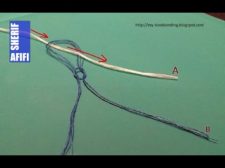
Every time I need to attach a new thread I have problems remembering how to tie a weaver’s knot. Eventually I decide a square knot will do. Continue reading →
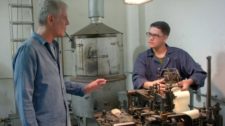
Anthony Bourdain & The Balvenie head to San Francisco, California to meet with Andrew Hoyem, master typographer and printer of Arion Press. One of the last of its kind, Arion Press has only a handful of members on its staff, all fellow craftsmen dedicated to this age old process. Each works meticulously to create the books in multiple parts, from the typecasters, to the proofreaders, to the printers and the bookbinders. All of these hands build a work of art through a process that must be seen to be believed, and can only, truly, be described as magic. Continue reading →

Hydraulic Press Channel is trying to figure if it is possible to fold a sheet of paper 7 times. I didn’t expect what happened in the end =) Continue reading →
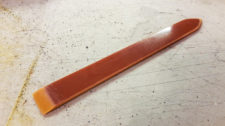
Several weeks ago I have ordered 3 mm thick 20×20 cm (77⁄8” x 77⁄8“) Bakelite sheet from China (you can easily find them at Amazon.com, eBay or AliExpress) to experiment a little with Bakelite folders. I almost always use bone folders and make wooden or laminate wood folders for my students (cheap and fast, you know). Continue reading →

I’m preparing for a new workshop now and need to find some early examples of use of codices by the Jewish community. Look like the oldest surviving examples are from the Cairo Genizah. I understand there are some mentions of earlier (not surviving) codices. Am I right? Continue reading →
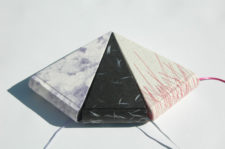
There is some real math behind the rectangular sheets of paper. At least if you work with ISO paper sizes. Measurements of the widespread A4 are derived from the size of A0 – it has an area of exactly 1 m2. For the B series every next size is also half as large (or twice as large – depending on the direction you choose to go) as the previous. B0 is defined by the length of its larger side – it is exactly 1 meter long. Both of them have the same aspect ratio: square root of 2. Continue reading →

It is time to apply for one of the scholarships offered by the American Academy of Bookbinding. I’ve used that chance last year and I’m very happy that I was lucky to receive the scholarship and to attend two wonderful courses: Box Making with Peter Geraty and Fine Binding with Don Glaister. These three weeks were one of the best I had in the recent years =) Continue reading →

Even if you make only simple bindings it is always worth spending some time on cover design. Check these two TED lectures by an American graphic designer Chip Kidd. Continue reading →
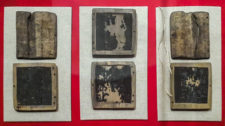
Summer of the year 2000 was a celebratory time for Russian archaeologists. On the 13 of July a new finding was made at the never-ceasing dig location in one of the oldest Russian cities of Novgorod. Three waxed wooden plates (19×15×1 cm) with remnants of text later appeared to be parts of the oldest known Russian book. Continue reading →
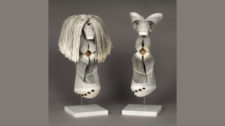
We have already wrote about artists interested in the afterlife of books. They cut through the pages searching for the hidden images and new forms. Now you can compare different approaches from a score of creators: on the 5th of February a new exhibition opens at the Everhart Museum in Scranton (PA, USA). Continue reading →
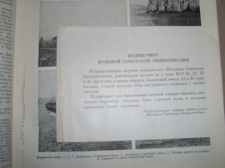
Soviet era is known for its many bizarre instances of censorship. Vanishing of the commissars may be the most famous, and you can find more in the Wikipedia. However, that’s all about photographs, and I’d like to share with you a bookbinding-related story. Continue reading →
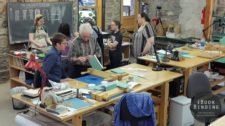
In the beginning of January, iBookBinidng.com started updating a constellation of its most popular posts — lists of bookbinding workshops and classes in different countries. The first one that is almost updated already is Bookbinding Workshops / Classes in the UK (2016). Continue reading →

That was a good but rather complicated year for both iBookBinding.com and myself. Here are some of the important events for the website: Continue reading →
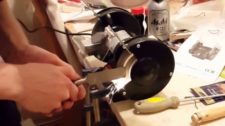
Last week I’ve tried to use a makeshift plough to trim several books. It took me more than three hours to create that plough from a chisel with sandpaper. Several days ago, I had to visit a hardware store, and found there a cheap Chinese bench grinder (like $20 cheap). After a moment of hesitation, I bought it along with several different chisels to experiment with. Continue reading →
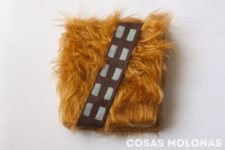
I’ve spent some time searching for examples of bookbinding inspired by Star Wars. Unfortunately, it looks like there are no fine bindings in a galaxy far, far away. However, there are really nice books made by hobbyists. Continue reading →